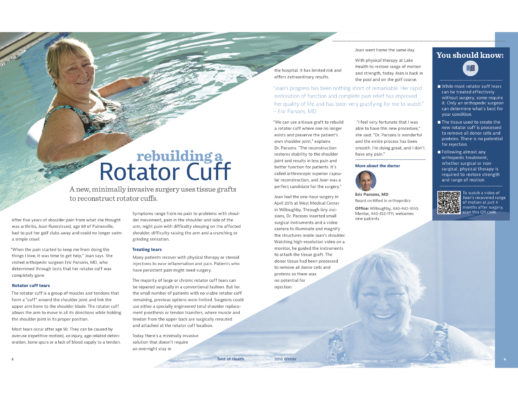Rebuilding a Rotator Cuff
After five years of shoulder pain from what she thought was arthritis, Joan Runestrand, age 69 of Painesville, had to put her golf clubs away and could no longer swim a simple crawl.
“When the pain started to keep me from doing the things I love, it was time to get help,” Joan says. She visited orthopedic surgeon Eric Parsons, MD, who determined through tests that her rotator cuff was completely gone.
Rotator cuff tears
The rotator cuff is a group of muscles and tendons that form a “cuff” around the shoulder joint and link the upper arm bone to the shoulder blade. The rotator cuff allow the arm to move in all its directions while holding the shoulder joint in its proper position.
Most tears occur after age 50. They can be caused by overuse (repetitive motion), an injury, age-related deterioration, bone spurs or a lack of blood supply to a tendon.
Symptoms range from no pain to problems with shoulder movement, pain in the shoulder and side of the arm, night pain with difficulty sleeping on the affected shoulder, difficulty raising the arm and a crunching or grinding sensation.
Treating tears
Many patients recover with physical therapy or steroid injections to ease inflammation and pain. Patients who have persistent pain might need surgery.
The majority of large or chronic rotator cuff tears can be repaired surgically in a conventional fashion. But for the small number of patients with no viable rotator cuff remaining, previous options were limited. Surgeons could use either a specially engineered total shoulder replacement prosthesis or tendon transfers, where muscle and tendon from the upper back are surgically rerouted and attached at the rotator cuff location.
Today there’s a minimally invasive solution that doesn’t require an overnight stay in the hospital. It has limited risk and offers extraordinary results.
“We can use a tissue graft to rebuild a rotator cuff where one no longer exists and preserve the patient’s own shoulder joint,” explains Dr. Parsons. “The reconstruction restores stability to the shoulder joint and results in less pain and better function for patients. It’s called arthroscopic superior capsular reconstruction, and Joan was a perfect candidate for the surgery.”
Joan had the one-hour surgery in April 2015 at West Medical Center in Willoughby. Through time incisions, Dr. Parsons inserted small surgical instruments and a video camera to illuminate and magnify the structures inside Joan’s shoulder. Watching high-resolution video on a monitor, he guided the instruments to attach the tissue graft. The donor tissue has been processed to remove all donor cells and proteins so there was no potential for rejection.
Joan went home the same day.
With physical therapy at Lake Health to restore range of motion and strength, today Joan is back in the pool and on the golf course.
“I feel very fortunate that I was able to have this new procedure,” she said. “Dr. Parsons is wonderful and the entire process has been smooth. I’m doing great, and I don’t have any pain.”

